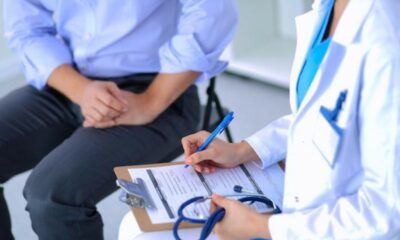Health
5 Physical Therapy Exercises For Lumbar Spinal Stenosis Relief

Are you or someone you love suffering from lumbar spinal stenosis? This condition can be challenging, but physical therapy exercises can be a game-changer. These exercises can help reduce pain, improve mobility, and improve overall quality of life. Let’s learn about six effective exercises that don’t require special equipment and that you can do in the comfort of your home.
Exercise #1: Pelvic Tilts
Pelvic tilts are a basic exercise that can help reduce the discomfort of stenosis. Here’s how to do them:
- Put your feet flat on the ground and lie on your back with your knees bent.
- Tighten your abdominal muscles and push your lower back to the floor by tilting your pelvis upward.
- Once you have held this position for a few seconds, release it.
- Repeat this exercise 10–15 times.
Pelvic tilts help strengthen the muscles that support your lower back and promote proper spinal alignment.
Exercise #2: Knee-to-Chest Stretch
The knee-to-chest stretch is an effective way to reduce the pain and discomfort associated with this condition. To do this stretch,
- Stretch your legs out on your back.
- Grab both hands around one knee and bring it to your chest.
- Hold for 20–30 seconds, feeling the stretch in your lower back and buttocks.
- Switch to the other knee and repeat.
Exercise #3: Cat-Cow Stretch
The Cat-Cow Stretch is a yoga-inspired exercise that can improve spinal flexibility and reduce discomfort. Here’s how to do it:
- Assume an all-fours position, with your wrists aligned with your shoulders and your knees with your hips.
- Take a deep breath while arching your back, lifting your head and tailbone towards the ceiling (the “cow” position).
- Exhale as you round your back, tucking your chin and tailbone (the “cat” position).
- Repeat this movement 10–15 times.
Exercise #4: Wall Sitting
Wall sits are a great exercise to strengthen your lower back and legs. To fulfill them,
- Stand with your back to a wall.
- Ensure your knees are bent 90 degrees as you slide down the wall.
- Hold this position for 20–30 seconds or as long as possible.
- Gradually increase your duration over time.
Exercise #5: Hip Bridges
Hip bridges are excellent for strengthening your lower back, buttocks, and thigh muscles. Here’s how to do them:
- Put your feet flat on the floor and your hands at your sides while lying on your back.
- Lift your hips off the ground by pushing through your heels, forming a straight line from your shoulders to your knees.
- Maintain this position for a few seconds, then gradually lower your hips..
- Perform 2-3 sets of 10-15 repetitions.
Conclusion
Integrating these physical therapy exercises into your daily regimen can significantly improve lumbar spinal stenosis management. These routines reduce discomfort, increase flexibility, and strengthen the vital muscles supporting the lower back. Before starting an exercise program, seek guidance from a healthcare professional. Various wellness resources, such as ANSSI Wellness, can help you.
Remember, with commitment and proper exercise, you can increase your overall quality of life.
Related Articles:
- Lower Back Pain Treatment, Symptoms & Causes
- Back Pain Treatment, Symptoms & Causes
- Cervical Spinal Canal Stenosis Treatment, Symptoms & Causes
-

 Business3 weeks ago
Business3 weeks agoPrakash and Kamal Hinduja: Driving Social and Environmental Change
-
Education4 weeks ago
Fred DuVal: University Leadership as a Critical Resource for Climate Change Research and Life-Saving Solutions
-

 Health3 weeks ago
Health3 weeks agoThe Hinduja Brothers Commitment to Global Health: Empowering Communities Across Borders
-

 Cryptocurrency3 weeks ago
Cryptocurrency3 weeks agoDesigned For The Masses: How Akasha (AK1111) Is Unlocking Crypto For The Next Billion Users
-

 Cryptocurrency4 weeks ago
Cryptocurrency4 weeks agoNexaglobal & Future World Token (FWT): Could This Be the Next Big Crypto Investment of 2025?
-

 Sports4 weeks ago
Sports4 weeks agoWomen’s NCAA Tournament 2025 Sweet 16: Full Schedule, Fixtures, Teams, Bracket, and How to Watch March Madness Basketball Match Live
-

 Startup1 week ago
Startup1 week agoCost-Saving Strategies Every Small Business Owner Should Know to Boost Efficiency
-

 Startup3 weeks ago
Startup3 weeks agoMatthew Denegre on the Art of Deal Sourcing: Finding the Right Investment Opportunities















